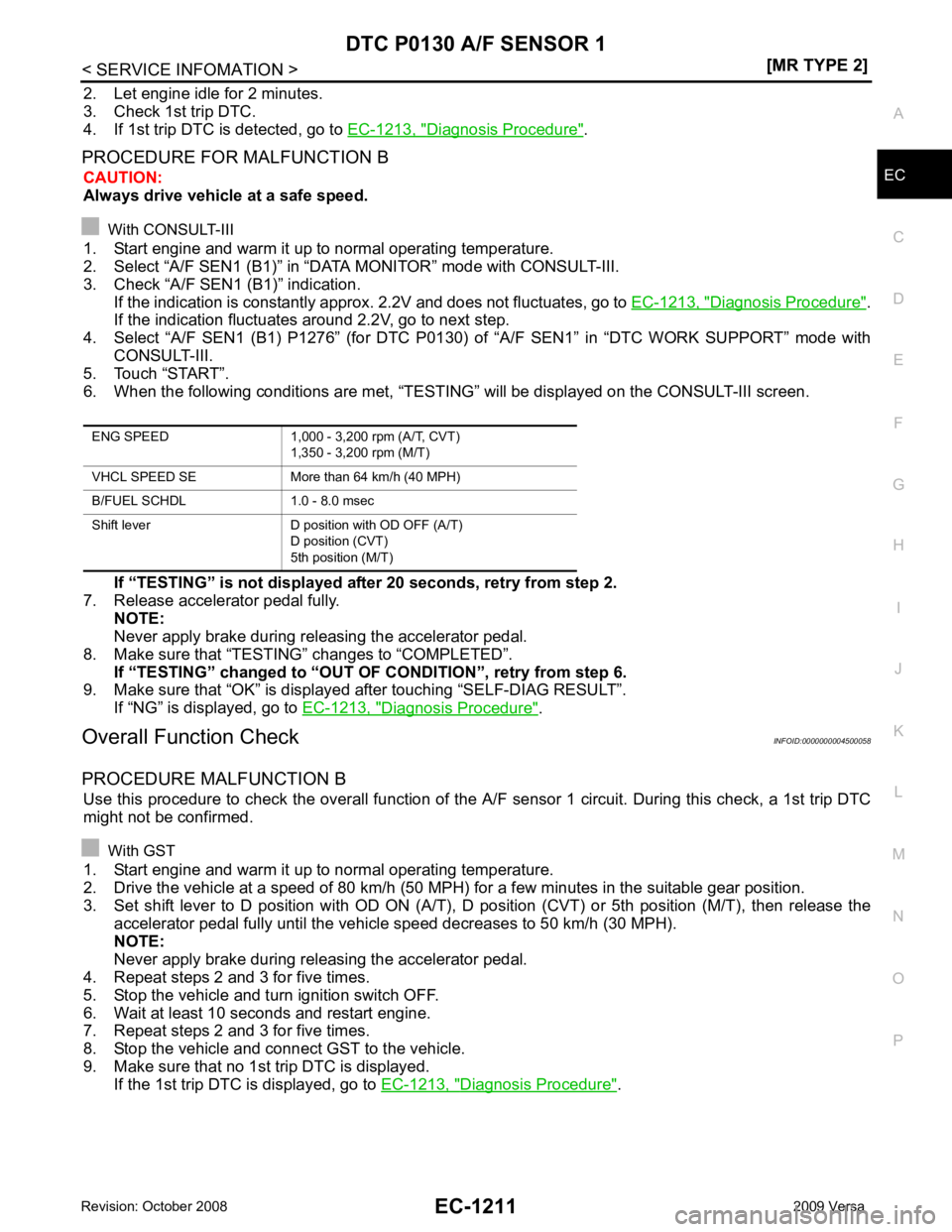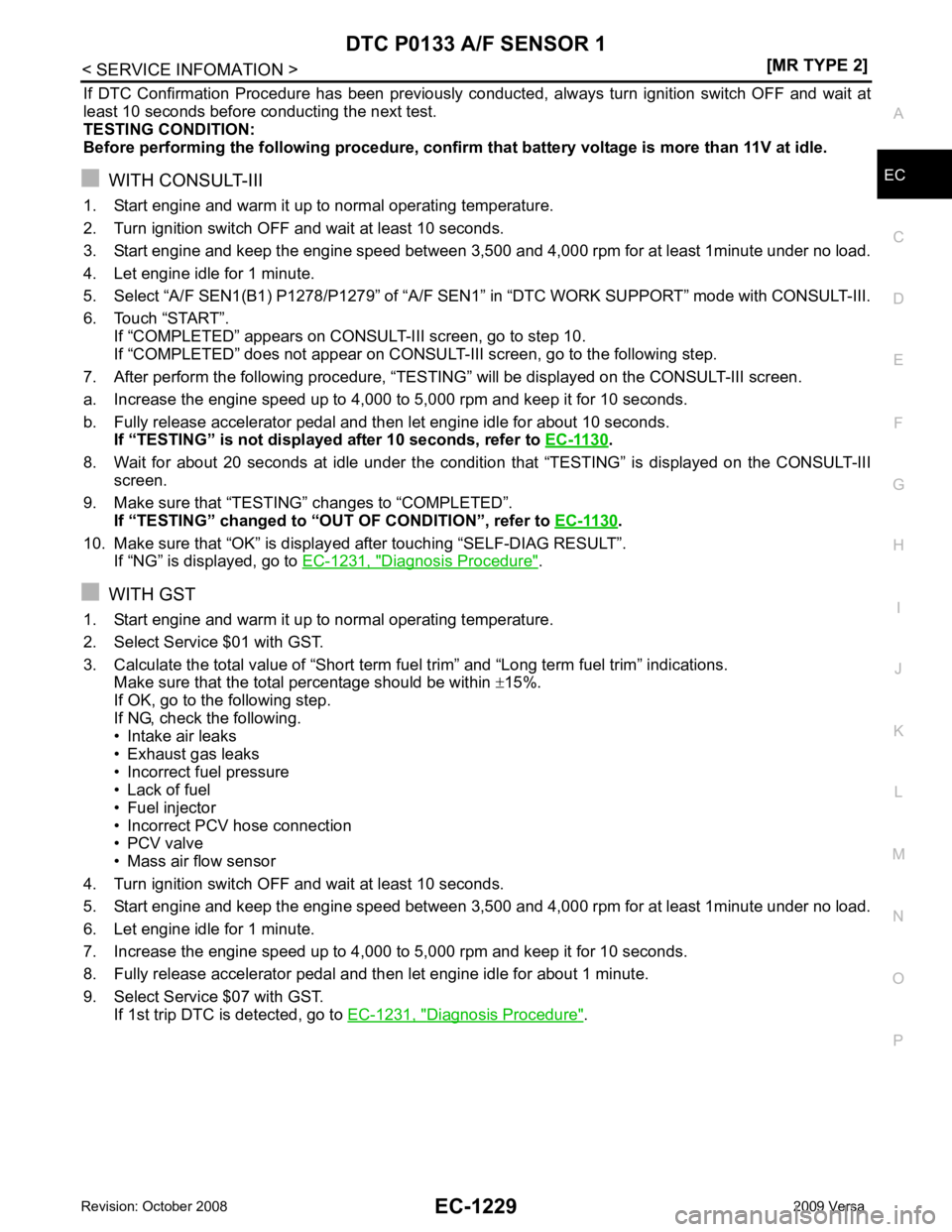2009 NISSAN LATIO display
[x] Cancel search: displayPage 2545 of 4331
![NISSAN LATIO 2009 Service Repair Manual DTC P0116 ECT SENSOR
EC-1189
< SERVICE INFOMATION >
[MR TYPE 2] C
D E
F
G H
I
J
K L
M A EC
NP
O
DTC P0116 ECT SENSOR
Component Description INFOID:0000000004500022
The engine coolant temperature sensor NISSAN LATIO 2009 Service Repair Manual DTC P0116 ECT SENSOR
EC-1189
< SERVICE INFOMATION >
[MR TYPE 2] C
D E
F
G H
I
J
K L
M A EC
NP
O
DTC P0116 ECT SENSOR
Component Description INFOID:0000000004500022
The engine coolant temperature sensor](/manual-img/5/57359/w960_57359-2544.png)
DTC P0116 ECT SENSOR
EC-1189
< SERVICE INFOMATION >
[MR TYPE 2] C
D E
F
G H
I
J
K L
M A EC
NP
O
DTC P0116 ECT SENSOR
Component Description INFOID:0000000004500022
The engine coolant temperature sensor is used to detect the engine
coolant temperature. The sensor modifies a voltage signal from the
ECM. The modified signal returns to the ECM as the engine coolant
temperature input. The sensor uses a thermistor which is sensitive to
the change in temperature. The electrical resistance of the ther-
mistor decreases as temperature increases.
*: This data is reference value and is measured between ECM terminal 38 (Engine
coolant temperature sensor) and ground.
CAUTION:
Do not use ECM ground terminals wh en measuring input/output voltage. Doing so may result in dam-
age to the ECM's transistor. Use a ground ot her than ECM terminals, such as the ground.
On Board Diagnosis Logic INFOID:0000000004477349
NOTE:
If DTC P0116 is displayed with P0117 or P0118, first perform the trouble diagnosis for DTC P0117,
P0118. Refer to EC-1193, " DTC Confirmation Procedure " .
DTC Confirmation Procedure INFOID:0000000004477350
NOTE:
If DTC Confirmation Procedure has been previously conduc ted, always turn ignition switch OFF and wait at
least 10 seconds before conducting the next test.
TESTING CONDITION:
Before performing the following procedure, do not add fuel.
1. Start engine and warm it up to normal operating temperature.
2. Rev engine up to 2,000 rpm for more than10 minutes.
3. Move the vehicle to a cool place, then stop engine and turn ignition switch OFF.
4. Check resistance between “fuel level s ensor unit and fuel pump” terminals 4 and 5.
5. Soak the vehicle until the resistance between “fuel level sensor unit and fuel pump” terminals 4 and 5
becomes 0.5 k Ω higher than the value measured before soaking.
CAUTION:
Never turn ignition switch ON during soaking time. SEF594K
Engine coolant temperature
°C ( °F) Voltage* V Resistance k
Ω
–10 (14) 4.4 7.0 - 11.4 20 (68) 3.5 2.1 - 2.9
50 (122) 2.2 0.68 - 1.00
90 (194) 0.9 0.236 - 0.260 SEF012P
DTC No. Trouble diagnosis name DTC detecting condition Possible cause
P0116
0116 Engine coolant tempera-
ture sensor circuit range/
performance Engine coolant temperature signal from engine
coolant temperature sensor does not fluctuate,
even when some time has passed after starting
the engine with pre-warming up condition. • Harness or connectors
(High or low resistance in the circuit)
• Engine coolant temperature sensor
Page 2549 of 4331

EC
NP
O
DTC Confirmation Procedure
INFOID:0000000004500024
NOTE:
If DTC Confirmation Procedure has been previously conduc ted, always turn ignition switch OFF and wait at
least 10 seconds before conducting the next test.
WITH CONSULT-III
1. Turn ignition switch ON and wait at least 5 seconds.
2. Check DTC.
3. If DTC is detected, go to EC-1194, " Diagnosis Procedure " .
Detected items Engine operating condition in fail-safe mode
Engine coolant temper- ature sensor circuit Engine coolant temperature will be determined by ECM based on the following condition.
CONSULT-III displays the engine coolant temperature decided by ECM.
Condition Engine coolant temperature decided
(CONSULT-III display)
Just as ignition switch is turned ON or START 40 °C (104 °F)
Approx. 4 minutes or more after engine starting. 80 °C (176 °F)
Except as shown above 40 - 80
°C (104 - 176 °F)
(Depends on the time)
When the fail-safe system for engine coolant temperature sensor is activated, the cooling fan operates while
engine is running.
Page 2553 of 4331
![NISSAN LATIO 2009 Service Repair Manual DTC P0122, P
0123 TP SENSOR
EC-1197
< SERVICE INFOMATION >
[MR TYPE 2] C
D E
F
G H
I
J
K L
M A EC
NP
O
DTC P0122, P0123 TP SENSOR
Component Description INFOID:0000000004500029
Electric throttle cont NISSAN LATIO 2009 Service Repair Manual DTC P0122, P
0123 TP SENSOR
EC-1197
< SERVICE INFOMATION >
[MR TYPE 2] C
D E
F
G H
I
J
K L
M A EC
NP
O
DTC P0122, P0123 TP SENSOR
Component Description INFOID:0000000004500029
Electric throttle cont](/manual-img/5/57359/w960_57359-2552.png)
DTC P0122, P
0123 TP SENSOR
EC-1197
< SERVICE INFOMATION >
[MR TYPE 2] C
D E
F
G H
I
J
K L
M A EC
NP
O
DTC P0122, P0123 TP SENSOR
Component Description INFOID:0000000004500029
Electric throttle control actuator consists of throttle control motor,
throttle position sensor, etc. The throttle position sensor responds to
the throttle valve movement.
The throttle position sensor has two sensors. These sensors are a
kind of potentiometers which transform the throttle valve position into
output voltage, and emit the voltage signal to the ECM. In addition,
these sensors detect the opening and closing speed of the throttle
valve and feed the voltage signals to the ECM. The ECM judges the
current opening angle of the throttle valve from these signals and the
ECM controls the throttle control motor to make the throttle valve
opening angle properly in response to driving condition.
CONSULT-III Reference Val ue in Data Monitor Mode INFOID:0000000004500030
Specification data are reference values.
*: Throttle position sensor 2 signal is converted by ECM internally. Thus, it differs from ECM terminal voltage signal.
On Board Diagnosis Logic INFOID:0000000004500031
These self-diagnoses have the on e trip detection logic.
NOTE:
If DTC P0122 or P0123 is displayed with DTC P0643, first perform the trouble diagnosis for DTC P0643.
Refer to EC-1396 .
FAIL-SAFE MODE When the malfunction is detected, ECM ent ers fail-safe mode and the MIL lights up.
DTC Confirmation Procedure INFOID:0000000004500032
NOTE:
If DTC Confirmation Procedure has been previously conduc ted, always turn ignition switch OFF and wait at
least 10 seconds before conducting the next test.
TESTING CONDITION:
Before performing the following procedure, confirm that battery voltage is more than 8V at idle.
1. Start engine and let it idle for 1 second.
2. Check DTC.
3. If DTC is detected, go to EC-1199, " Diagnosis Procedure " . PBIB0145E
MONITOR ITEM CONDITION SPECIFICATION
TP SEN 1-B1
TP SEN 2-B1* • Ignition switch: ON
(Engine stopped)
• Shift lever: D (A/T, CVT),
1st (M/T) Accelerator pedal: Fully released More than 0.36V
Accelerator pedal: Fully depressed Less than 4.75V DTC No. Trouble diagnosis name DTC detecting condition Possible cause
P0122
0122 Throttle position sensor
2 circuit low input An excessively low voltage from the TP sensor
2 is sent to ECM. • Harness or connectors
(TP sensor 2 circuit is open or shorted.)
• Electric throttle control actuator (TP sensor 2)
P0123
0123 Throttle position sensor
2 circuit high input An excessively high voltage from the TP sensor
2 is sent to ECM. Engine operation condition in fail-safe mode
The ECM controls the electric throttle control actuator in regulating the throttle opening in order for the idle position to be within +10
degrees.
The ECM regulates the opening speed of the throttle valve to be slower than the normal condition.
So, the acceleration will be poor.
Page 2558 of 4331
![NISSAN LATIO 2009 Service Repair Manual EC-1202< SERVICE INFOMATION >
[MR TYPE 2]
DTC P0125 ECT SENSOR
DTC P0125 ECT SENSOR
Component Description INFOID:0000000004501093
The engine coolant temperature sensor is used to detect the engine
coo NISSAN LATIO 2009 Service Repair Manual EC-1202< SERVICE INFOMATION >
[MR TYPE 2]
DTC P0125 ECT SENSOR
DTC P0125 ECT SENSOR
Component Description INFOID:0000000004501093
The engine coolant temperature sensor is used to detect the engine
coo](/manual-img/5/57359/w960_57359-2557.png)
EC-1202< SERVICE INFOMATION >
[MR TYPE 2]
DTC P0125 ECT SENSOR
DTC P0125 ECT SENSOR
Component Description INFOID:0000000004501093
The engine coolant temperature sensor is used to detect the engine
coolant temperature. The sensor modifies a voltage signal from the
ECM. The modified signal returns to the ECM as the engine coolant
temperature input. The sensor uses a thermistor which is sensitive to
the change in temperature. The elec trical resistance of the ther-
mistor decreases as temperature increases.
*: This data is reference value and is measured between ECM terminal 38 (Engine
coolant temperature sensor) and ground.
CAUTION:
Do not use ECM ground terminals when measuring in put/output voltage. Doing so may result in dam-
age to the ECM's transistor. Use a ground ot her than ECM terminals, such as the ground.
On Board Diagn osis Logic INFOID:0000000004500038
NOTE:
• If DTC P0125 is displayed with P0117 or P0118, firs t perform the trouble diagnosis for DTC P0117 or P0118.
Refer to EC-1193, " DTC Confirmation Procedure " .
• If DTC P0125 is displayed with P0116, first perform the trouble diagnosis for DTC P0116. Refer to EC-1202," DTC Confirmation Procedure " .
DTC Confirmation Procedure INFOID:0000000004500039
CAUTION:
Be careful not to overheat engine.
NOTE:
If DTC Confirmation Procedure has been previously conduc ted, always turn ignition switch OFF and wait at
least 10 seconds before conducting the next test.
WITH CONSULT-III
1. Turn ignition switch ON.
2. Select “DATA MONITOR” mode with CONSULT-III.
3. Check that “COOLAN TEMP/S” is above 10 °C (50 °F). SEF594K
Engine coolant temperature
°C ( °F) Voltage* V Resistance k
Ω
–10 (14) 4.4 7.0 - 11.4 20 (68) 3.5 2.1 - 2.9
50 (122) 2.2 0.68 - 1.00
90 (194) 0.9 0.236 - 0.260 SEF012P
DTC No. Trouble diagnosis name DTC detecting condition Possible cause
P0125
0125 Insufficient engine cool-
ant temperature for
closed loop fuel control • Voltage sent to ECM from the sensor is not
practical, even when some time has passed
after starting the engine.
• Engine coolant temperature is insufficient for closed loop fuel control. • Harness or connectors
(High resistance in the circuit)
• Engine coolant temperature sensor
• Thermostat
Page 2567 of 4331

EC
NP
O
2. Let engine idle for 2 minutes.
3. Check 1st trip DTC.
4. If 1st trip DTC is detected, go to EC-1213, " Diagnosis Procedure " .
PROCEDURE FOR MALFUNCTION B CAUTION:
Always drive vehicle at a safe speed.
With CONSULT-III
1. Start engine and warm it up to normal operating temperature.
2. Select “A/F SEN1 (B1)” in “DAT A MONITOR” mode with CONSULT-III.
3. Check “A/F SEN1 (B1)” indication.
If the indication is constantly approx . 2.2V and does not fluctuates, go to EC-1213, " Diagnosis Procedure " .
If the indication fluctuates around 2.2V, go to next step.
4. Select “A/F SEN1 (B1) P1276” (for DTC P0130) of “A/F SEN1” in “DTC WORK SUPPORT” mode with
CONSULT-III.
5. Touch “START”.
6. When the following conditions are met, “TESTIN G” will be displayed on the CONSULT-III screen.
If “TESTING” is not displayed after 20 seconds, retry from step 2.
7. Release accelerator pedal fully.
NOTE:
Never apply brake during releasing the accelerator pedal.
8. Make sure that “TESTING” changes to “COMPLETED”.
If “TESTING” changed to “OUT OF CONDITION”, retry from step 6.
9. Make sure that “OK” is display ed after touching “SELF-DIAG RESULT”.
If “NG” is displayed, go to EC-1213, " Diagnosis Procedure " .
Overall Function Check INFOID:0000000004500058
PROCEDURE MALFUNCTION B Use this procedure to check the overall function of the A/F sensor 1 circuit. During this check, a 1st trip DTC
might not be confirmed.
With GST
1. Start engine and warm it up to normal operating temperature.
2. Drive the vehicle at a speed of 80 km/h (50 MPH) for a few minutes in the suitable gear position.
3. Set shift lever to D position with OD ON (A/T), D position (CVT) or 5th position (M/T), then release the
accelerator pedal fully until the vehicle speed decreases to 50 km/h (30 MPH).
NOTE:
Never apply brake during releasing the accelerator pedal.
4. Repeat steps 2 and 3 for five times.
5. Stop the vehicle and turn ignition switch OFF.
6. Wait at least 10 seconds and restart engine.
7. Repeat steps 2 and 3 for five times.
8. Stop the vehicle and connect GST to the vehicle.
9. Make sure that no 1st trip DTC is displayed. If the 1st trip DTC is displayed, go to EC-1213, " Diagnosis Procedure " .
Page 2573 of 4331

EC
NP
O
If the indication is not constantly approx. 0V, go to next step.
4. Turn ignition switch OFF, wait at least 10 seconds and then restart engine.
5. Drive and accelerate vehicle to more than 40 km/h (25 MPH) within 20 seconds after restarting engine.
6. Maintain the following conditions for about 20 consecutive seconds.
NOTE:
• Keep the accelerator pedal as steady as possible during the cruising.
• If this procedure is not completed within 1 minute after restarting engine at step 4, return to step
4.
7. Check 1st trip DTC.
8. If 1st trip DTC is displayed, go to EC-1219, " Diagnosis Procedure " .
WITH GST
Follow the procedure “WITH CONSULT-III” above. ENG SPEED 1,000 - 3,200 rpm
VHCL SPEED SE More than 40 km/h (25 MPH)
B/FUEL SCHDL 1.5 - 9.0 msec
Shift lever Suitable position
Page 2579 of 4331

EC
NP
O
If the indication is not constantly approx. 5V, go to next step.
4. Turn ignition switch OFF, wait at least 10 seconds and then restart engine.
5. Drive and accelerate vehicle to more than 40 km/h (25 MPH) within 20 seconds after restarting engine.
6. Maintain the following conditions for about 20 consecutive seconds.
NOTE:
• Keep the accelerator pedal as steady as possible during the cruising.
• If this procedure is not completed within 1 minute after restarting engine at step 4, return to step
4.
7. Check 1st trip DTC.
8. If 1st trip DTC is displayed, go to EC-1225, " Diagnosis Procedure " .
WITH GST
Follow the procedure “WITH CONSULT-III” above. ENG SPEED 1,000 - 3,200 rpm
VHCL SPEED SE More than 40 km/h (25 MPH)
B/FUEL SCHDL 1.5 - 9.0 msec
Shift lever Suitable position
Page 2585 of 4331

EC
NP
O
If DTC Confirmation Procedure has been previously conduc
ted, always turn ignition switch OFF and wait at
least 10 seconds before conducting the next test.
TESTING CONDITION:
Before performing the following procedure, confirm that battery voltage is more than 11V at idle.
WITH CONSULT-III
1. Start engine and warm it up to normal operating temperature.
2. Turn ignition switch OFF and wait at least 10 seconds.
3. Start engine and keep the engine speed between 3,500 and 4,000 rpm for at least 1minute under no load.
4. Let engine idle for 1 minute.
5. Select “A/F SEN1(B1) P1278/P1279” of “A/F SEN1 ” in “DTC WORK SUPPORT” mode with CONSULT-III.
6. Touch “START”. If “COMPLETED” appears on CONSULT-III screen, go to step 10.
If “COMPLETED” does not appear on CONSULT- III screen, go to the following step.
7. After perform the following procedure, “TESTIN G” will be displayed on the CONSULT-III screen.
a. Increase the engine speed up to 4,000 to 5,000 rpm and keep it for 10 seconds.
b. Fully release accelerator pedal and then let engine idle for about 10 seconds. If “TESTING” is not displayed after 10 seconds, refer to EC-1130 .
8. Wait for about 20 seconds at idle under the conditi on that “TESTING” is displayed on the CONSULT-III
screen.
9. Make sure that “TESTING” changes to “COMPLETED”. If “TESTING” changed to “OUT OF CONDITION”, refer to EC-1130 .
10. Make sure that “OK” is display ed after touching “SELF-DIAG RESULT”.
If “NG” is displayed, go to EC-1231, " Diagnosis Procedure " .
WITH GST
1. Start engine and warm it up to normal operating temperature.
2. Select Service $01 with GST.
3. Calculate the total value of “Short term f uel trim” and “Long term fuel trim” indications.
Make sure that the total percentage should be within ±15%.
If OK, go to the following step.
If NG, check the following.
• Intake air leaks
• Exhaust gas leaks
• Incorrect fuel pressure
• Lack of fuel
• Fuel injector
• Incorrect PCV hose connection
• PCV valve
• Mass air flow sensor
4. Turn ignition switch OFF and wait at least 10 seconds.
5. Start engine and keep the engine speed between 3,500 and 4,000 rpm for at least 1minute under no load.
6. Let engine idle for 1 minute.
7. Increase the engine speed up to 4,000 to 5,000 rpm and keep it for 10 seconds.
8. Fully release accelerator pedal and then let engine idle for about 1 minute.
9. Select Service $07 with GST. If 1st trip DTC is detected, go to EC-1231, " Diagnosis Procedure " .